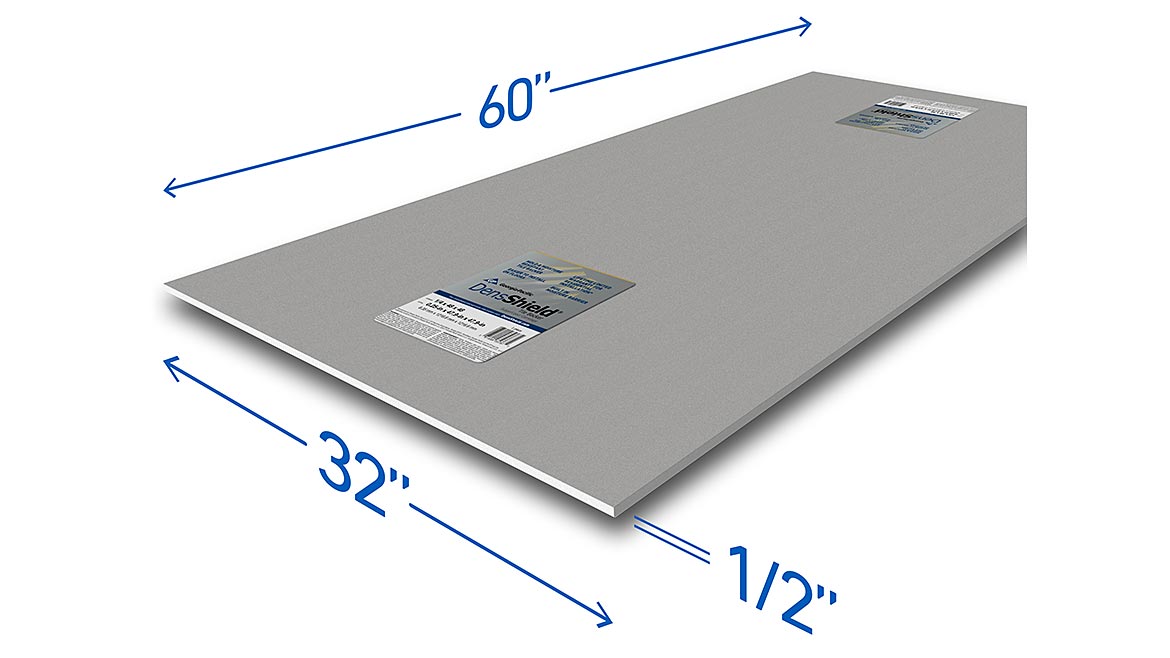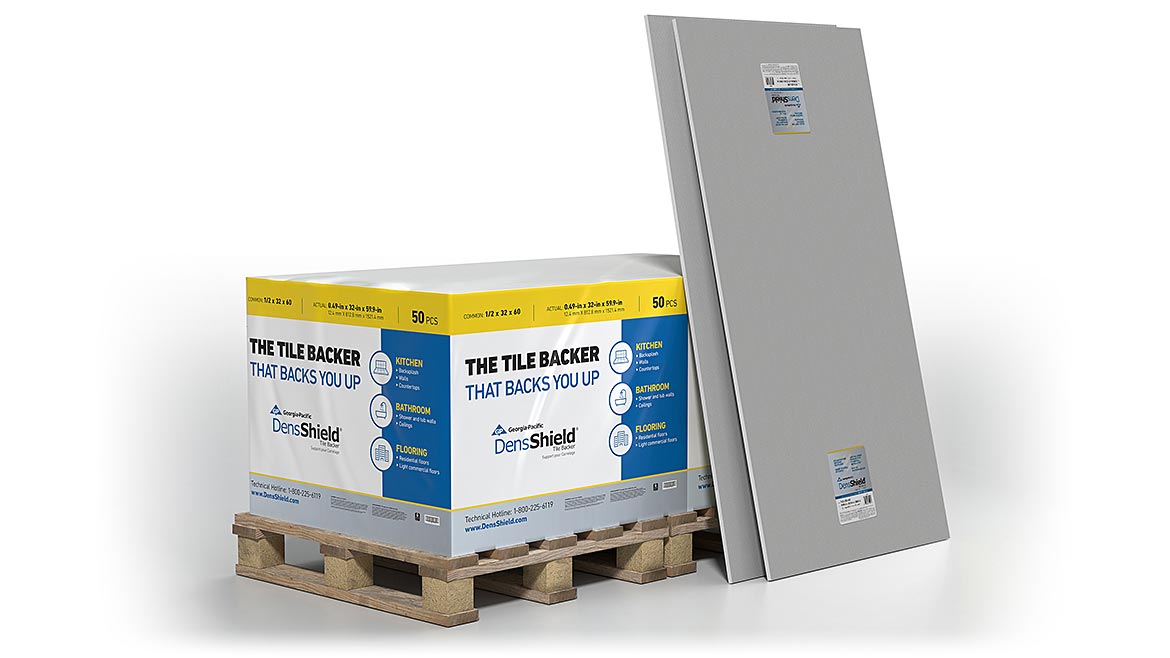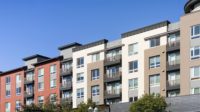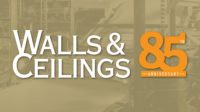Construction professionals have known about the benefits of gypsum for well over a century. The first drywall prototypes were developed in the late 1880s. By the 1950s, a post-war baby boom solidified gypsum drywall’s position among the most influential building products in history. But the innovation didn’t stop there.
Modifications to original paper-faced drywall have created a category of rigid fiberglass mat gypsum tile backer boards that outperform alternative products in both workability and durability. In a construction industry climate where labor is tight and materials costs are high, these fiberglass mat gypsum tile backer boards help ensure construction projects come in on time, on budget, and will stand the test of time.
What is Fiberglass Mat Gypsum Tile Backer Board?
Rigid fiberglass mat gypsum tile backer board was developed out of the industry’s need for a wall tile substrate that would thrive in a home’s wet spaces—notably the bathroom and kitchen. Drywall’s paper facing provided a food source for mold, while wood sheathing absorbed water too easily to support tile installations long-term. Cement board was—and remains—heavy and hard to work with, often requiring specialized cutting tools, all of which increases labor costs.
Comprised of naturally occurring calcium sulfate and select additives, the industry knew rigid fiberglass mat gypsum boards provided inherent durability and fire-resistance that homebuilders were looking for. By replacing drywall’s paper facing with an integral fiberglass mat moisture barrier, manufacturers created a new category of rigid tile backer board. These fiberglass mat drywall products, available in varying lengths and 1/4-, 1/2-, and 5/8-inch thicknesses, leveraged gypsum’s strength-to-weight ratio and bolstered its water resistance in a way that would allow the boards to support tile installations in the most demanding rooms of the home.

Gypsum Tile Backer Board vs. Cement Board
Currently, about 60 percent of the tile backer board market is taken up by cement-based sheet materials, either with or without an embedded fiberglass mesh. This means that more than half of wall and tile contractors are dealing with the added labor expenses that come with these heavy sheets, dusty site conditions, and additional moisture barrier requirements—all without gaining any performance advantages.
Weight: Comparing 1/2-inch materials around the category, gypsum tile backer board weighs approximately two pounds per square foot, depending on the manufacturer. This is a substantial difference from cement board products, which range from 2.5 to 3 psf. At 20 to 33 percent lighter weight, gypsum materials are easier to maneuver around jobsites and can be handled by a single installer, even when carried longer distances, such as to an upstairs bathroom.
Material Handling: Crew members carrying lighter gypsum tile backer sheets around the jobsite will also be happy to hear that they don’t need to make additional trips to outdoor work areas to have the sheets cut to size. Most cement board requires carbide- or diamond-tipped knives for small cuts and more involved saw setups for longer cuts. Because of potentially hazardous silica dust created when cutting cement board, these cutting stations must be set up in well-ventilated areas, usually outside, and crew members may be required to wear additional safety gear such as respirator masks in order to maintain jobsite safety standards.
Gypsum tile backer, however, helps reduce jobsite hazards with easier workability. The materials score and snap as easily as their drywall counterparts, so cutting stations can be bypassed altogether. Simply carry the lighter-weight material straight to the installation area and cut it by hand to fit the space.
Installation: Cement board may require specialized fasteners to install the product whereas fiberglass mat gypsum tile backers don’t. For fiberglass mat gypsum materials with an integrated moisture barrier, simply seal the seams with fiberglass mesh tape and a skim coat of your preferred thinset and you’re ready to tile. These panels feature a fiberglass mat as well as layers of factory-applied acrylic moisture barrier for added moisture resistance without added work.
Without an integral moisture barrier, cement board installations will require a membrane moisture barrier to be installed prior to setting tile. This prevents moisture from penetrating the material, but adding a second step to the installation further increases installation time and labor costs.

Avoiding Moisture-Related Tile Backer Failure
Both cement board and non-paper-faced gypsum tile backer are inorganic and inherently mold-resistant. Users should look for a mold-resistance score of 10 on their preferred material’s data sheets. However, both materials take on water, so water resistance (percent by weight) and surface water absorption testing per ASTM C473 yielding results of ≤ 5 and ≤ 0.5, respectively, are also ideal.
In a laboratory environment, moisture resistance is tested by monitoring how much water the substrate absorbs over a 48-hour period. While integral and installer-applied moisture barriers will prevent water from moving into the face of a cement or gypsum panel, the untreated edges are where the problems can occur.
With this in mind, proper seam taping, tile spacing, and use of properly specified grout are essential, as is caulking seams at the wet-/dry-space transition. Leaving seams unsealed, and incorrectly aligning or grouting the tile itself can leave entire projects vulnerable to moisture intrusion, which can damage walls from the inside out.
Improperly tiled walls that take on water over time experience crumbling grout, loose and broken tiles, and mold formation due to water moving through the tile backer and into the wood framing.
Gypsum Solves a Century of Tile Backer Board Woes
Since its inception as a sheathing for walls, fiberglass mat gypsum has been held in high regard for its combination of strength, durability, and ease of use. Now with integral moisture barriers, fiberglass mat gypsum tile backer board is an obvious, problem-solving solution for a home’s wet spaces, as well.
This is an important consideration for construction teams struggling with labor concerns. Fiberglass mat gypsum tile backer can be easily installed by drywall crews or other existing team members cross-trained to finish showers, tub surrounds, kitchen backsplashes and other moisture-prone areas without the need for additional staff or subcontractors. Likewise, on-hand crews that currently use cement board for these installations can save time and maximize efficiency with lightweight, easy-to-install gypsum.
No matter the project, the use of fiberglass mat gypsum tile backer board is growing in popularity as more professionals recognize the product’s cost-saving benefits. And as an easy switch from cement board, the category is sure to keep growing and innovating for another 100 years.






Report Abusive Comment